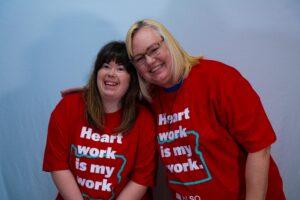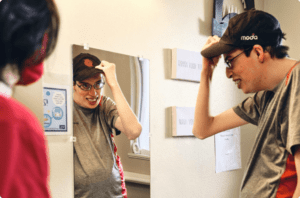Support our diverse communities by buying tickets from the ALSO HEARTS raffle fundraiser! Tickets are available until July 31st, 2025.
Support our diverse communities by buying tickets from the ALSO HEARTS raffle fundraiser! Tickets are available until July 31st, 2025.

Our discussion on community inclusion (also known as community integration) for people with disabilities begins with some important statements:
“Every person with disability is an individual.” -Itzhak Perlman
“Accessibility allows us to tap into everyone’s potential.” -Debra Ruh
The team at Advocates for Life Skills and Opportunity (ALSO) agrees passionately with the wise words above. That’s why we’re guided by a bold vision in which all people with intellectual and developmental disabilities have the same opportunities for a life full of potential.

ALSO envisions a future in which all people, including those living with developmental and other disabilities are fully included, participating members of their communities. We see equitable access to supports and services that reflect the preferences and values of diverse communities and that lead to self-determination, independence, productivity, and a healthy and satisfying quality of life.
Today we talk about what this vision means for people with intellectual and developmental disabilities. We also share how true inclusion for all people creates a vibrant, thriving, and caring community.
The United Nations Convention on the Rights of Persons with Disabilities recognizes that we all belong to the same human family. Therefore, the rights of those with disabilities must also be considered as human rights. They emphasize that everyone is entitled to the same freedoms to work, play, and thrive in a life of their choosing.
Data indicates that among the 7.4 million individuals with intellectual or developmental disabilities using long-term support who live in the United States, only 12% live in their own homes. Others live with guardians, family members, in foster homes, or in group homes. This separation from the larger society imposes severe limits on community participation and social inclusion.
Without the benefits of community inclusion and opportunities to function at full potential, persons with disabilities have a higher risk of health disparities and extreme poverty. Specifically, they can all-too-easily experience the following:
Community integration provides countless benefits to persons with developmental and intellectual disabilities, including:
READ MORE: Disability self-advocate Kaaren Londahl explains her determination to help people with intellectual and developmental disabilities “be in the community and live like anybody else.”
READ MORE: World Bank emphasizes that disability inclusion is a key factor in improved socioeconomic status and health outcomes.

When people of all ability levels experience true inclusion, overall society also reaps rewards.
The result for everyone, whether or not they have a disability, is more discretionary consumer dollars, which in turn fuels the economy.
The 1960s and 70s brought several improvements to the treatment of persons with intellectual and developmental disabilities. Disability rights advocates, families, and policymakers worked tirelessly to improve access to basic services, high-quality education, fair employment, and independent living. However, despite all this progress, there was still much more work to be done. Not everywhere experienced the same amount of progress and many institutions that housed people with disabilities away from their communities were still in use.
The Developmental Disabilities Act provided financial assistance for major improvements in community-based services. The main goal was to maximize the potential for persons with developmental disabilities to become fully integrated into community life.
In 1990, the Americans with Disabilities Act (ADA) was signed. It prohibits discrimination and establishes rights for all people with disabilities in the following:
The Olmstead Decision was initiated by two women with developmental disabilities who were detained in a psychiatric facility against their will, even though their providers reported they were ready to progress to community-based services. The United States Supreme Court sided with the women, stating that unjustified segregation of persons with disabilities violates the ADA.
Although disability advocates have made incredible progress in promoting full community integration for persons with disabilities, more work is on the horizon.
We often pride ourselves on being free of prejudice and other forms of bias towards other human beings. However, a common occurrence when interacting with persons who have intellectual or developmental disabilities is a behavior called implicit bias.
Implicit bias is frequently triggered unconsciously and can be quite surprising once we realize it. Often, the matter is brought to our attention by a direct support professional (DSP), advocate, or social services provider.
One type of implicit bias is called the spread effect. This is when people assume that a disability negatively affects other abilities and personality traits. For example:
It is important to understand and acknowledge these types of biases in order to learn, connect, and grow. By recognizing and eliminating implicit bias, we can become better advocates for people with disabilities.
Getting a handle on our habits of implicit bias is one of the many ways to promote full community inclusion. The American Bar Association (ABA) describes several ways to address implicit bias.
Making these adjustments to thoughts and actions sets an excellent example. Others will learn to do the same.
LEARN MORE: You can take other steps to battle implicit bias. Check out this article from the ABA: Implicit Bias and People with Disabilities.
Many people promote true inclusion for people with intellectual and developmental disabilities by becoming an advocate. Here’s some ideas from the team at ALSO:
Being an advocate on disability issues doesn’t need to take a lot of time or money. Don’t feel like you need to be an expert. All you need to do is care.

Employers play a major role in equal opportunities for persons with intellectual and developmental disabilities. Why is inclusion important in the workplace? Part of it has to do with injustices that have occurred in the past.
Not long ago, sheltered workshops were virtually the only option for people with intellectual and developmental disabilities. However, this work was anything but inclusive and meaningful. Individuals were segregated and put into sub-minimum wage jobs that were boring and repetitive.
Those who toiled in these sub-standard conditions were unable to achieve economic independence. They couldn’t even pay for their health services. This pushed people with disabilities into extreme poverty, isolation, and poor health. On top of that, it was very damaging to their self-esteem and a sense of self-worth.
Even after the signing of the ADA, change was slow. Sheltered workshops were fully present in the United States into the early 2000’s. It took the work of countless disability rights activists, policy makers, and local community members to promote inclusion in the workplace for persons with intellectual and developmental disabilities.
Whether you’re a small, medium, or large employer, you have a part to play in creating inclusive employment programs that benefit people with intellectual and developmental disabilities. We at ALSO ask that you consider the following:
LEARN MORE: Sheltered Workshops to Individual Empowerment.

Everyone at ALSO embraces community inclusion of people with intellectual and developmental disabilities as a personal mission. We’re fully committed to the best practices of the human rights-based approach as we help them achieve their life goals. We’re honored to offer the following support services:
There’s so much you can do to make the world a better place:
Be part of the solution! Contact ALSO today at info@alsoweb.org.

Sign up for our newsletter to get our latest news, content, and job opportunities.
Help us ensure that everyone has the same opportunities in their home, workplace and community. Let’s make dreams!
